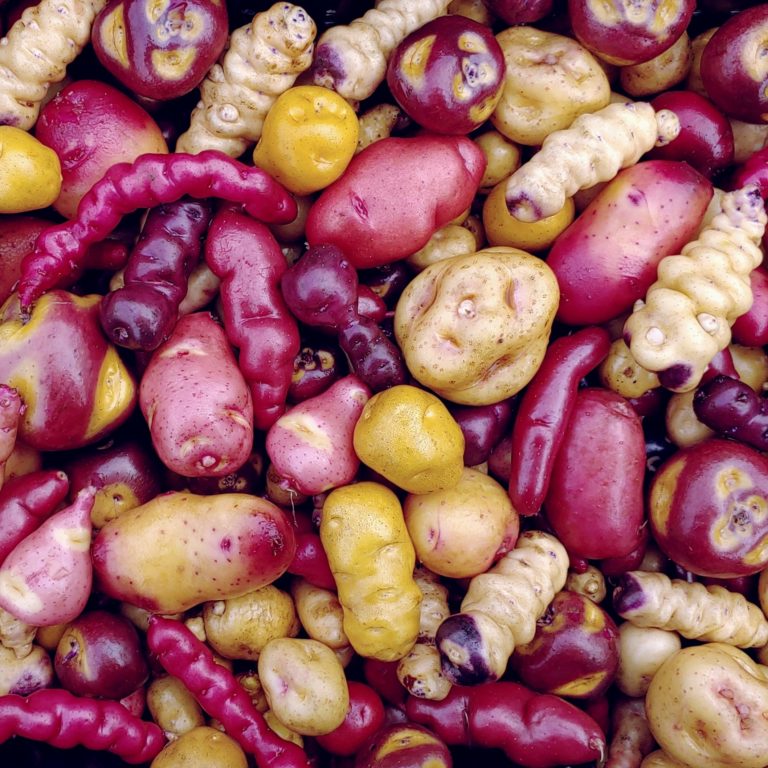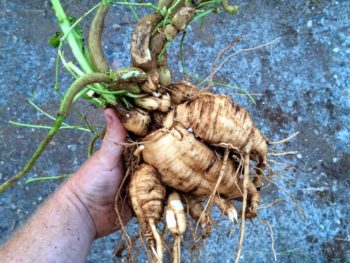
 14
14




A build too cool to miss:Mike's GreenhouseA great example:Joseph's Garden
All the soil info you'll ever need:
Redhawk's excellent soil-building series





 11
11




 15
15




Leora Laforge wrote:Asparagus is the only vegetable that I ever think of with perennial veg. Do you have rhubarb? Not really a veggie, but definitely a perennial. Spinach and lettuce are annuals, but if you let them go to seed they will often reseed themselves, which has the low maintenance factor of perennials. Lambsquarters, purslane, and dandelions all kind of taste like spinach as long as you pick them early in the growing season, and since those are actual weeds they are super easy to grow.
A build too cool to miss:Mike's GreenhouseA great example:Joseph's Garden
All the soil info you'll ever need:
Redhawk's excellent soil-building series





 13
13




Trace Oswald wrote:
I don't grow rhubarb for the same reason I don't grow cranberries. I have a rule (my own rule, that applies to me only), that if I have to add a ton of sugar to something to make it edible, it isn't edible.
 15
15




 8
8




It's never too late to start! I retired to homestead on the slopes of Mauna Loa, an active volcano. I relate snippets of my endeavor on my blog : www.kaufarmer.blogspot.com
 26
26




If someone ever makes the Avengers of gardeners, my goal is to make that team!

 8
8




 6
6




Aimee Hall wrote:I do understand your desire to have them taste good. I feel much the same way, though I feel that there are many perennial vegetables up to the task. Some that I highly recommend and personally enjoy the flavour of (though I know tastes are different for everyone) and I think most of these should be able to survive in zone 4b:...
A build too cool to miss:Mike's GreenhouseA great example:Joseph's Garden
All the soil info you'll ever need:
Redhawk's excellent soil-building series





 4
4




Catie George wrote:Perennial vegetables are more of a short seasoned novelty in my garden than a staple.
A build too cool to miss:Mike's GreenhouseA great example:Joseph's Garden
All the soil info you'll ever need:
Redhawk's excellent soil-building series





 8
8






 12
12




 4
4




Jan White wrote:I'm with you on the rhubarb, Trace.
I just planted them this year so I'm not sure how they'll perform, but I got a couple things from store.experimentalfarmnetwork.org that seem promising.
One is homesteader's kaleidoscopic perennial kale grex and the other is Deitrich's wild broccoli raab, which is a self-seeding biennial.
In 20 years I've never successfully grown kale. No matter where I've been or what kind of soil, including my current place, the kale has always been stunted and covered in aphids. This grex is all big and beautiful with no aphids. Most of the best plants are big leaved collard types.
The raab is in pots to be planted out when it cools down a bit. The leaves are a little strong to eat them raw in large quantities, but they're nice cooked. Like turnip greens. A few plants went to seed this year, and raabs are tasty. I only ate one, though, cause I want the seeds.
I have a patch of the raab growing that I don't even remember planting. I must have sprinkled some around in random places before hedging my bets with some in pots. The random patch came up and thrived all summer under very challenging conditions.
A build too cool to miss:Mike's GreenhouseA great example:Joseph's Garden
All the soil info you'll ever need:
Redhawk's excellent soil-building series





 11
11




Trace Oswald wrote:
I am planting a lot more things like spinach that I can let go to seed. I do have lambsquarters and dandelions growing, but I don't really eat them. I've never tried cooking them, only eating them raw. I can eat them, but I wouldn't say I enjoy them much. I like purslane raw, but don't have it at my current land.
Weeds are just plants with enough surplus will to live to withstand normal levels of gardening!--Alexandra Petri
 13
13




 8
8




. . . bathes in wood chips . . .
 8
8




If someone ever makes the Avengers of gardeners, my goal is to make that team!
 6
6




 7
7




 6
6




If someone ever makes the Avengers of gardeners, my goal is to make that team!
 13
13




 7
7




Trace Oswald wrote:I love the idea of growing and eating them, but the taste leaves a lot to be desired, in my opinion. Look at the number of times you see Linden tree leaves being touted as a vegetable. I have to believe no one that adds them to a list has ever eaten one. If you try them, you'll quickly finding out they taste like, well, a tree leaf, and they aren't a good substitute for any vegetable I ever ate.
So, here is my question. What perennial vegetable actually taste good enough to be a substitute for the roughly equivalent annual vegetable? I'm in zone 4b, so that rules out a lot of things I can grow. I have dozens of fruit trees and berry bushes planted in my food forest, but I would really like to have some perennial vegetables growing, short of the few things I have. Currently I have asparagus and horseradish, and that is about it. Any ideas of great tasting, cold hardy veggies?
Thank for your time.
Maybe Life is always like being on a trapeze or a tightrope at the circus...
 12
12




 8
8




 10
10




 1
1




If someone ever makes the Avengers of gardeners, my goal is to make that team!
 4
4




 2
2




Trace Oswald wrote:Look at the number of times you see Linden tree leaves being touted as a vegetable. I have to believe no one that adds them to a list has ever eaten one.
Check out the Food Forest Card Game: https://permies.com/wiki/141665/Food-Forest-card-game-English








 11
11






 3
3




Mathew Trotter wrote:I have a lot of interest in the Andean root and tuber crops: oca, mashua, achira, ulluco, mauka, arracacha,yacon, dahlia, etc. This will be my first year with many of these crops so I can't comment on flavor, but most are purported to have qualities akin to the more common roots and tubers we eat
Check out the Food Forest Card Game: https://permies.com/wiki/141665/Food-Forest-card-game-English
 2
2




Nothing ruins a neighborhood like paved roads and water lines.
 4
4




Mark Reed wrote:I've wondered if the flower buds were edible and the one video says they are and they produce abundantly. I've also wondered regarding both if the immature seed pods can be eaten as they both produce lots of them.
Check out the Food Forest Card Game: https://permies.com/wiki/141665/Food-Forest-card-game-English
 1
1




Nothing ruins a neighborhood like paved roads and water lines.
 2
2




Karl Treen wrote:
Mathew, I'd love to hear the results from your root crops this year, especially mauka. Please let me know how it goes.
Karl Treen wrote: I can comment on edible dahlia. I started growing seeds from Cultivariable a couple of years ago and have been perfecting the genetics of a compact variety that I tastes quite good. Many of them taste like you're eating a pine cone, and I have heard that some taste like radishes.
Mark Reed wrote:I remember Carol Deppe talking about them and that some are more tasty than others. They are not difficult to grow from seed so I have wondered about breeding them for better food quality. I didn't know you could also eat the roots so breeding for bigger roots would be a fun project.
I knew you could eat cattails but didn't know they had such good nutritional content. They along with waterlilies though would be quite a messy chore to harvest considering where they grow.
I'm definitely going to look into that Nine Star perennial broccoli that one lady spoke of, I'd love to add that into my brassica mix that I'm working on now.
 1
1




 1
1




Mathew Trotter wrote:
I've been trying to hunt down Nine Star for years now. I've only ever found two sources in the states, but they've both been out for probably a couple of years now and just this year both removed Nine Star from their websites. If you happen to find some, I'm very interested. But, given the difficulty of tracking that one down, I'm now thinking about crossing the Kaleidoscope perennial kale with my annual broccolis and trying to develop a perennial broccoli that way. I'm not sure what the odds of success are, but since broccoli is my favorite brassica, I'm willing to toil with that project for a while.
Check out the Food Forest Card Game: https://permies.com/wiki/141665/Food-Forest-card-game-English




Karl Treen wrote:
Mathew, I really, really have to put in another plug for using sea kale for perennial broccoli production. The flavor is, truly, even better than broccoli. The broccolis won't arrive until your sea kale is in its second year but will proliferate with age until you have lots of reliable broccoli with almost no effort whatsoever. The toughest part is getting your sea kale plants through year 1. After that, they're pretty nearly unstoppable unless you have very persistent animals eating them.
If you are in the states and need sea kale roots to try, reach out to me using the contact form at the bottom of my homepage FoodForestGardenClub.org. I think the ground is warm enough for me to dig some up for you. I'm very happy to send them to you.
 2
2




Nothing ruins a neighborhood like paved roads and water lines.

|
Can't .... do .... plaid .... So I did this tiny ad instead:
Rocket Mass Heater Resources Wiki
https://permies.com/w/rmh-resources
|





